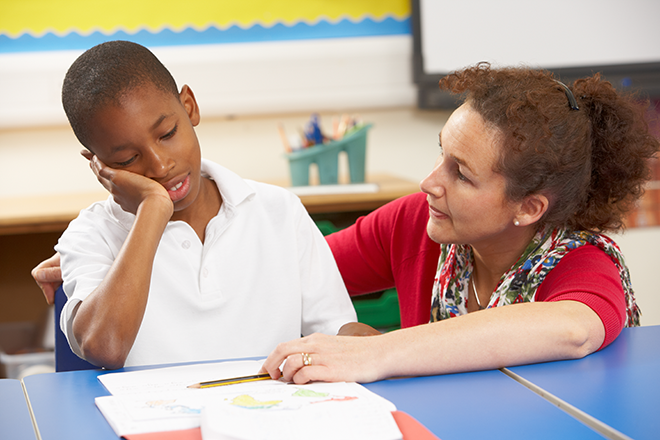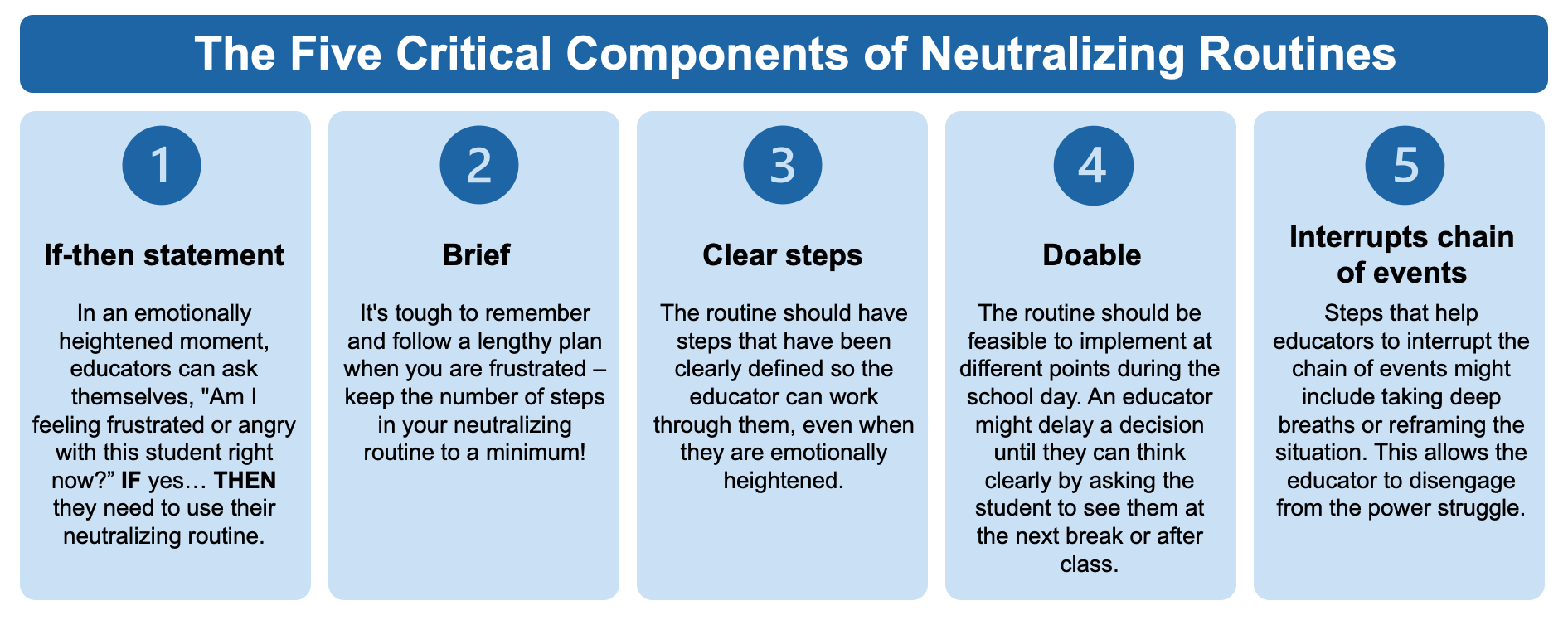
Part 3 of Equity and PBIS: This is the final post of our series “An Equity-Centered Approach of Positive Behavioral Interventions and Supports (PBIS)”. Read Part 1: Importance of an equity-centered approach or Part 2: Engaging Students and Families in Equity-Focused PBIS.
In the second post in our Promises and Pitfalls of PBIS series, we discussed how to elevate the voices of students and families – one aspect of implementing a positive behavior framework that is preventive, multi-tiered, and culturally responsive. In this third post, we will highlight strategies educators can use to reduce implicit bias when responding to challenging behaviors, which is one of the five key components to reduce disproportionality in school discipline when implementing a PBIS approach.
Researchers at the Yale Child Study Center asked preschool teachers to watch a video recording of four Black and White students playing and asked them to press a button whenever they observed the student displaying behaviors that could become challenging. The researchers told the participants that the study was about detecting early signs of problem behaviors, but in reality, there were no challenging behaviors; instead, they used eye tracking technology to see where teachers were looking on the screen. They found that preschool teachers of all demographic backgrounds consistently looked at the Black boy the most, suggesting that they expected him to misbehave.
A critical aspect of building an inclusive classroom is for educators to engage in self-reflection around their implicit biases, or attitudes, behaviors, and actions that are prejudiced in favor of or against one person or group compared to another. We all carry preconceived notions and biases, regardless of whether we are aware of them – it’s part of being human! Implicit bias is unconscious and automatic, and it’s generally not an indication of our conscious beliefs and values. However, stereotypes, or overgeneralized beliefs about a particular group of people, can drive implicit biases by shaping educator beliefs about which students are more likely to display behaviors they perceive as challenging1 and whether they expect them to display additional difficult behaviors in the future.2 For example, one study conducted by researchers at the Yale Child Study Center showed that preschool teachers who were observing different children playing expected a Black boy to misbehave more than the other children.
Implicit biases can substantially impact how educators interact with their students and can result in inequitable consequences such as harsher discipline for students of color, particularly when educators make snap judgements in a emotionally charged situations. Luckily, there are steps educators can take to mitigate the actions or decisions that result in inequities for students. During our discussion with Dr. Kent McIntosh, we discussed ways that educators can identify situations where inequitable decisions are more likely to occur and then respond in a way that takes implicit bias into account and minimizes its impact.
Increasing awareness of important decision points
A crucial first step to mitigating the effects of implicit bias is understanding the types of decisions that are most prone to implicit bias and result in snap judgements – or, a vulnerable decision point (or VDP). VDPs are influenced by elements of the situation, such as the time of day or location, and a person’s state of mind, such as whether they’re tired, hungry, or preoccupied. For example, educators may be more prone to making snap decisions in response to what they perceive as challenging student behaviors when they are stressed or irritated. This is especially true when children display an ongoing pattern of perceived challenging behaviors, as this can be incredibly draining for educators and students alike. VDPs are generally more likely to occur:
This handout developed by Dr. McIntosh can be a useful tool in helping educators identify and document their own vulnerable decision points within their school’s unique context!
- In situations that involve subjective problem behaviors, such as what educators perceive as defiance, disrespect, disruption.
- In response to behaviors in non-classroom areas, like in the hallway or outside. Adults may be interacting with students who they do not know personally, and they may be more likely to rely on stereotypes.
- During certain times of day, such as before lunch when the onset of hunger sets in or in the afternoon when educators may experience more mental or physical fatigue.
Minimizing the impact of implicit bias
In addition to building an understanding of the VDPs they encounter, educators can also take steps to minimize the effects of implicit bias when they encounter challenging behaviors. A neutralizing routine is “an instructional response to unwanted behavior in place of a harsh response in times of stress”3. Neutralizing routines help educators to pause before responding to challenging behaviors instead engage in productive, supportive behaviors toward the student that align with their values.4 There are five critical components of neutralizing routines: 1) it contains an if-then statement, 2) it’s brief, 3) it has clear steps, 4) it’s doable, and 5) it interrupts the chain of events.5,6 The infographic below has additional details about each step!

Wondering what neutralizing routines can look like in practice? Two examples of clearly defined neutralizing routines are the STOP procedure7 and the TRY procedure.
- Stop your unconscious response.
- Take 2 mindful breaths to self-regulate.
- Observe how you are feeling.
- Proceed positively by doing what is most effective (not what you initially feel like saying or doing).
- Take a deep breath.
- Reflect on your emotions.
- Youth’s best interest. (This can mean telling the student, “Let’s try that again” or “Let’s try it a different way.”)
A few final thoughts
Educators are confronted with challenging student behaviors on a regular basis, and their ability to respond to those behaviors in an equitable way is critical to the success of any PBIS system. We hope this blog builds awareness and provides educators with tools to reflect on their implicit biases, understand their vulnerable decision points, and develop neutralizing routines that help them to engage in productive and supportive behaviors with their students!
References
1Gilliam, W. S., Maupin, A. N., Reyes, C. R., Accavitti, M., & Shic, F. (2016). Do early educators’ implicit biases regarding sex and race relate to behavior expectations and recommendations of preschool expulsions and suspensions. Yale University Child Study Center, 9(28), 1-16.
2Kunesh, C. E., & Noltemeyer, A. (2019). Understanding Disciplinary Disproportionality: Stereotypes Shape Pre-Service Teachers’ Beliefs About Black Boys’ Behavior. Urban Education, 54(4), 471–498.
3https://static.sched.com/hosted_files/capbis2019/76/McIntosh%20Neutralizing%20Routine%20handouts.pdf
4Cook, C. R., Duong, M. T., McIntosh, K., Fiat, A. E., Larson, M., Pullmann, M. D., & McGinnis, J. (2018). Addressing discipline disparities for Black male students: Linking malleable root causes to feasible and effective practices. School Psychology Review, 47(2), 135-152. https://nepbis.org/wp-content/uploads/2020/06/Neutralizing-Routines-Final.pptx
5Downs, C., & Maki, E. School-wide positive behavioral interventions and supports: Neutralizing routines. Northeast PBIS & the Center on Positive Behavioral Interventions and Supports
6McIntosh, K. (2019). Neutralizing routines: Strategies to interrupt snap-judgement responses for staff and students. California PBIS Conference. https://capbis2019.sched.com/event/VEn0/6-a-neutralizing-routines-strategies-to-interrupt-snap-judgment-responses-for-staff-and-students
7Renshaw, T. L., Bolognino, S. J., Fletcher, S. P., & Long, A. C. J. (2015). Using mindfulness to improve well-being in school. NASP Communique, 43(6), 4–8.
Topics: Multi-tiered systems of support School climate School-wide prevention Social–emotional and behavioral challenges
